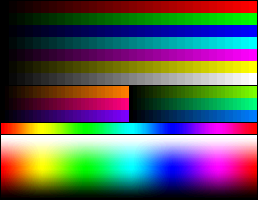hi, Switch_Z. you can have palettes with more than 256 colours. what i do is following:
- import palette i wish to use as gpl
- use FastBit colour picker
- often i also have a colour chart on screen to pick colours more quickly, something like this:

i load palette just to check if selected colour is indeed included and use WolftrooperNo86’s script for actual colour selection. if i feel like i want to pick colour more naturally, i pick it from colour chart and again check if that colour is in the palette. if it isn’t, FastBit checker can pick the closest colour for me.
since bigger palettes are very hard to navigate i believe this is the best way how to work with larger palettes we have now.
you can download gpl palettes for probably any hardware you wish (for example mega drive palette here). or optionally it is not hard to generate your own gpl palette by script (i use free program called processing for that).